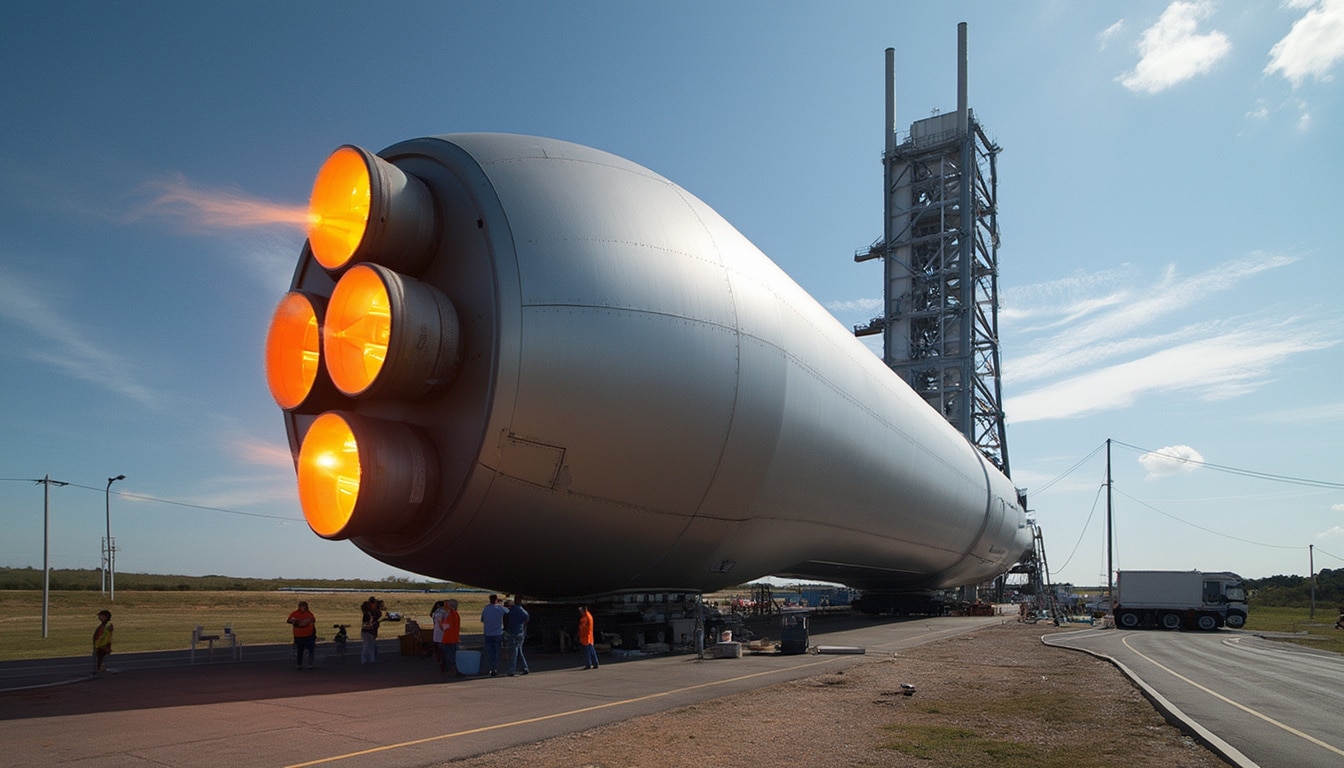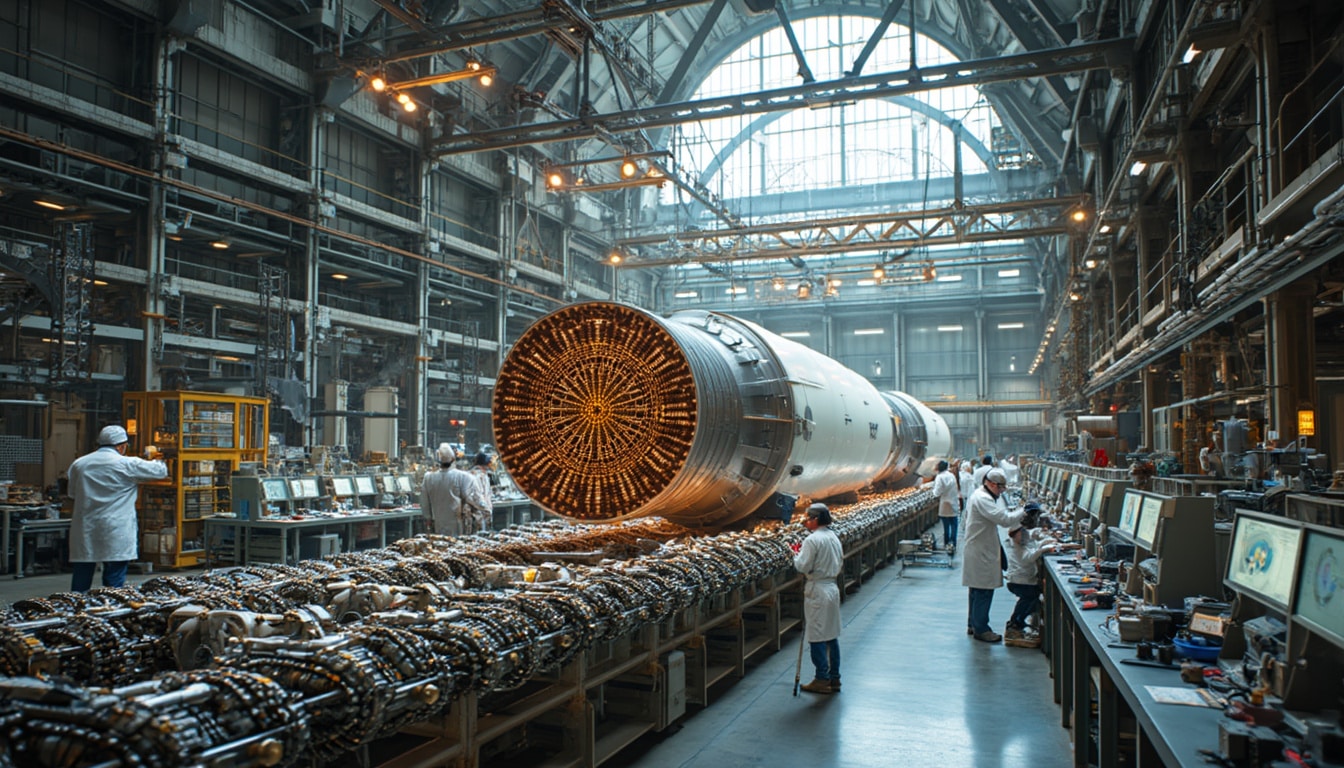As SpaceX pushes the boundaries of space exploration, the focus remains firmly on its Starship program, with Ship 35 leading the charge in a series of critical tests. The dynamic world of aerospace involves careful planning, extensive testing, and an intricate ballet of vehicles and technology, aimed squarely at the future of human space travel.
This article delves into the current status of SpaceX’s fleet, particularly the ongoing preparations and testing surrounding Ship 35. With multiple static fire tests under its belt and significant modifications aimed at improving performance, Ship 35 is a jewel in the crown of SpaceX’s rapidly growing arsenal. Meanwhile, other ships are in various stages of assembly and testing, laying the groundwork for ambitious missions ahead, while competitors like Boeing, Lockheed Martin, and Blue Origin circle in the ever-evolving battlefield of aerospace innovation.
The Testing Framework for Ship 35
The intricate process of preparation and testing of Ship 35 exemplifies SpaceX’s commitment to safety and efficiency. Following the stacking of Ship 35 in early February of this year, the company dedicated additional efforts to rectify issues surfaced during the previous flights, especially after the setbacks with Ship 33 and Ship 34. The extensive ground testing phase acts as a precursor to its eventual flight capabilities. For instance, the craft underwent cryogenic proof testing on March 11 and 12, a crucial step in validating its integrity under extreme conditions.

Dynamic Testing and Results
Upon completion of its proof tests, Ship 35 was transported back to Mega Bay 2 for necessary modifications and outfitting, specifically to facilitate its static fire tests. Recently, the ship was rolled out and successfully executed two significant static fire tests. The first involved a single engine test seen as a demonstration of its in-space burn capabilities, while the second was a six-engine static fire test.
However, an unexpected and abrupt shutdown of a Raptor Vacuum Engine marred the second test. While such incidents may appear alarming, they allow SpaceX engineering teams to gather invaluable data that can be reviewed and analyzed to improve future performances. Engaging in what could be termed an aggressive testing strategy, the team appears dedicated to identifying issues directly rather than relying solely on simulations.
Future Launch Considerations
The road ahead for Flight 9 remains uncertain, especially considering the challenges presented during the recent static fire tests. Originally projected for a launch around May 9 or 10, the timeline is now being scrutinized as engineers conduct potential troubleshooting. Flight 9 is believed to hinge not only on Ship 35’s performance but also on the debut of Booster 14, a critical element for this mission.
Booster 14, distinguished as SpaceX’s first re-fly of a Super Heavy booster, is already awaiting integration with Ship 35 in Mega Bay 1. The shared complexities between the ship and the booster require meticulous planning to ensure a flawless launch sequence.
Innovations and Enhancements in the Fleet
SpaceX’s efforts extend beyond just Ship 35; many vessels are in various stages of design and alteration, each contributing favorably to the evolving fleet. The development of Ship 36, for instance, is notable for its advanced heat shield design, which involves deploying a hex-shaped felt material for gap filling rather than the traditional Room Temperature Vulcanizing silicone. This novel approach not only streamlines the production process but also enhances the thermal protection capabilities of the spacecraft.

Upcoming Fleet Expansion: Ship 37 and Beyond
Ship 37, now finalized and in the process of assembly, is slated for Flight 11, and its design takes into account the learns from earlier flights, including those from Ship 35. As each ship undergoes tests, engineering teams utilize gathered data not just for immediate challenges but strategically for future vessels. The possibility of seeing Ship 37 as the first to enter orbit hinges significantly on how successful the upcoming tests with Ship 35 and subsequent Flights 9 and 10 turn out to be.
Additionally, the building of Ship 38 indicates SpaceX’s commitment to pushing the limits of what’s currently achievable. Despite not knowing the objectives of this vehicle yet, the ongoing development signifies a robust commitment to the Starship program’s ambitions.
The Competitive Aerospace Landscape
As SpaceX strides towards its ambitious goals, the competitive landscape continues to take shape, influenced by heavyweights like NASA, Boeing, Lockheed Martin, Virgin Galactic, and others. A multifaceted approach to space exploration is necessary, especially as various entities contribute to an overarching mission of humanity’s presence in space.
SpaceX’s Competitive Edge
With its agile testing processes and innovative designs, SpaceX maintains a unique edge in the competition. Companies like Arianespace and Rocket Lab certainly present formidable challenges, but SpaceX’s rapid development cycles, frequent launches, and comprehensive testing methodologies ensure they remain at the forefront of the industry. Considerable investments from tech giants such as Elon Musk’s ventures through various channels, including space traffic navigation with Starlink, further solidifies its position in an ever-evolving field.
Moreover, the cautious steps being taken toward NASA collaborations underscore a newly fostering relationship within the government space agency and the advances SpaceX continues to achieve with the Artemis missions, enhancing the populace’s excitement regarding forthcoming lunar missions.
Challenges and Opportunities
Challenges persist in maintaining a clear path forward, especially regarding the developmental roadblocks on various ships and boosters. What becomes evident is that every failure serves a goodwill purpose—an opportunity for improvement. As SpaceX looks ahead, it is striving for the balance between efficiency and safety. The upcoming tests and modifications for Ship 35 and its boosters not only serve to generate data but also create stories—stories of perseverance in innovation.
More than just engineering challenges, space missions represent the public’s hope for exploration and discovery. Delivering missions that can potentially open new realms of possibility is a daunting mission only few dare embark on.
Looking Ahead: The Future of SpaceX and Beyond
Future horizons are intricately linked to the success that SpaceX’s fleet achieves in the coming days. With the ongoing static testing for Ship 35 shaping both immediate future missions and the longer-term plans for the company, eyes are keenly trained on its outcomes. Plans for further booster launches, enhancements, and advanced prototypes signal an enduring journey of exploration, a journey shared with international competitors and governmental partnerships.
Artistful Embodiments: The Image of Space Exploration
The fascination surrounding space travel captivates imaginations globally, and as SpaceX endeavours to generate stunning visuals during launches and missions through each operation, public enthusiasm continues to surge. Linkages to creative portrayals through social media platforms help foster a sense of excitement about what comes next.
The ongoing journey of the Starship program encapsulates a realm of possibilities yet comes with the responsibility of ensuring every mission is met with readiness and meticulous execution. This journey embodies the passion shared by individual tech enthusiasts and seasoned aerospace professionals alike, urging people to look towards the skies with hope.
Through collaborations with entities such as NASA and private partnerships, opportunities to access new frontiers appear endless, and SpaceX emerges as an unrivaled pioneer prepared to lead the way in a new age of human discovery and exploration.
| Current SpaceX Fleet Status | Ship Type | Status | Flight Number | Projected Next Steps |
|---|---|---|---|---|
| Ship 35 | Starship | Testing static fire | 9 | Final checks before launch |
| Ship 36 | Starship | Awaiting static fire | 10 | Testing and integration |
| Ship 37 | Starship | In assembly | 11 | Cryogenic proof test |
| Booster 14 | Super Heavy | Prepared for re-fly | 9 | Integration with Ship 35 |
| Booster 15 | Super Heavy | Under refurbishment | Upcoming | Preparation for future flight |
| Booster 16 | Super Heavy | Ready for testing | 10 | Static fire test |
| Booster 17 | Super Heavy | Awaiting assembly | 12 | Preparation for upcoming missions |




Leave a Reply